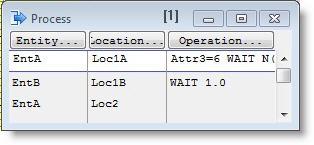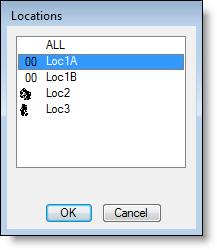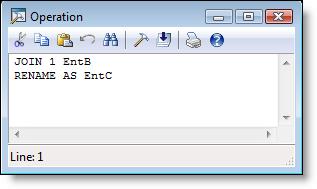
You are here: Building the Model: General Elements > Processing > Process Edit Table
The Process edit table is used to create operation logic for each entity type at each location in the system. Processes for entities at locations may be in any order in the edit table, but for the sake of organization you should group them by entity type or location. The only time the order of processes is significant is when the same entity is routed multiple times through the same location, in which case, later processes must appear somewhere after earlier processes. When searching for the next process, ProModel always searches forward in the process list first, and then starts from the beginning of the list.

An explanation of each field of the Process edit table is contained on the following pages.
Entity The entity type for which the process is defined. If all entities at the same location undergo the same operation or have the same routing, the reserved word ALL may be entered in this field. (See discussion on ALL later in this section.) If an entity not previously defined is entered in this field, ProModel will ask if it should create the new entity type.
Click on the heading button to bring up the Entities selection box. If this is a preemption process record, check the box (see Preemption Process Logic) and double click on an entity to automatically place it in the table. You can also click on an entity name and select OK to place it in the table.

The entity list box defaults to the current field entity, the last entity selected, or the first entity defined.
Location The location where the process occurs.
Click on the heading button to bring up the Locations selection box from which you may choose a location.

The location list box defaults to the current location, the last location selected, or the first location defined.
Specifying ALL in the Location field and omitting any routing defines a process for an entity at all locations previously specified as routing destinations for the entity. Because there is no routing, after the entity finishes that process, ProModel will search ahead in the Process edit table for a process for the entity specific to the actual location. The keyword ALL in the Location field is particularly useful when entities route to different locations having the same operations and then route to a common destination. In most other instances, it is recommended that a subroutine or macro be used to define identical operations.
Operation Operation logic is optional, but typically contains at least a wait statement for the amount of time the entity should spend at the location. If the entity needs a resource to process or to be combined in some way with other entities, that would be specified here as well. In fact, anything that needs to happen to the entity at the location should be specified here, except for any information specified in the entity's routing.
Statements can be typed directly into the operation field, or inside a larger logic window after double clicking in the field or clicking on the Operation button. Alternatively, the Logic Builder can help build logic and is accessed by clicking the right mouse button inside the operation field or logic window. All of the statements, functions, and distributions available in the operation field are discussed in detail, including examples, in Statements and Functions.
Each entity performs the operation steps defined for it at a particular location, independent of other operations performed on other entities at the same location.

For more information see Operation Logic.